 W
WThe Ahle Wurst, is a hard pork sausage made in northern Hesse, Germany. Its name is a dialectal form of alte Wurst – "old sausage".
 W
WA Beutelwurst is a German blood sausage, which contains more pieces of fat and flour than a normal Rotwurst.
 W
WBierschinken, or Schinkenwurst is a form of sausage or cold cut particularly common in German-speaking countries.
 W
WBierwurst is a German cooked, smoked Brühwurst sausage originally from Bavaria, with a garlicky flavor and dark red color. It is seasoned with black peppercorns, paprika, and mustard seeds for flavor.
 W
WBlood Tongue, or Zungenwurst, is a variety of German head cheese with blood. It is a large head cheese that is made with pig's blood, suet, bread crumbs and oatmeal with chunks of pickled beef tongue added. It has a slight resemblance to blood sausage. It is commonly sliced and browned in butter or bacon fat prior to consumption. It is sold in markets pre-cooked and its appearance is maroon to black in color.
 W
WBockwurst is a German sausage traditionally made from ground veal and pork. Bockwurst is flavored with salt, white pepper and paprika. Other herbs, such as marjoram, chives and parsley, are also often added and, in Germany, bockwurst is often smoked as well.
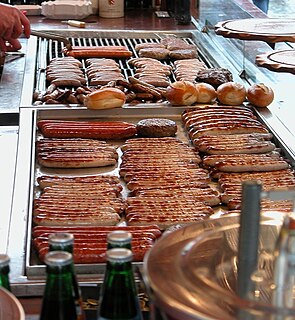 W
WBratwurst is a type of German sausage made from veal, beef, or most commonly pork. The name is derived from the Old High German Brätwurst, from brät-, finely chopped meat, and Wurst, sausage, although in modern German it is often associated with the verb braten, to pan fry or roast. Beef and veal are usually incorporated amongst a blend often including pork.
 W
WBraunschweiger is a type of sausage. The type of sausage the term refers to varies by region. In the German language, Braunschweiger is the demonym for people from Brunswick, but under German food law refers to a variety of mettwurst. In Austria, Braunschweiger is known as a type of parboiled sausage (Brühwurst), while American Braunschweiger is often confused with liverwurst.
 W
WBregenwurst is a specialty sausage of Lower Saxony and Saxony-Anhalt traditionally made of pork, pork belly, and pig or cattle brain.
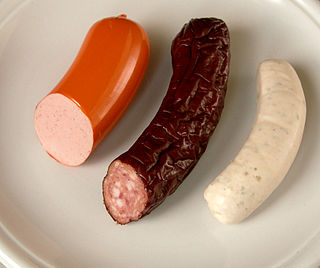 W
WBrühwurst is the collective name for several types of sausages according to the German classification. They are a cooked sausage that are scalded (parboiled), as opposed to being raw. They are typically prepared from raw meat that is finely-chopped, are sometimes smoked, and are typically served hot.
 W
WCervelat, also cervelas, servelat or zervelat, is a sausage produced in Switzerland, France and parts of Germany. The recipe and preparation of the sausage vary regionally.
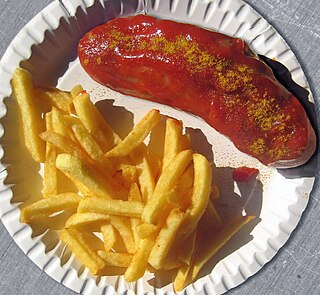 W
WCurrywurst is a fast food dish of German origin consisting of steamed, then fried pork sausage typically cut into bite-sized chunks and seasoned with curry ketchup, a sauce based on spiced ketchup or tomato paste topped with curry powder, or a ready-made ketchup seasoned with curry and other spices. This dish is often served with French fries.
 W
WA debrecener is a pork sausage of uniform fine texture and reddish-orange colour, named after the Hungarian city of Debrecen. The sausages are heavily spiced with paprika and other seasonings like garlic, pepper and marjoram. Usually they contain tiny pieces of pork fat as well. They are usually unsmoked or lightly smoked, and sold in pairs joined at one end. Traditional cooking technique calls for the Debreceni to be transversely slashed at intervals and baked, broiled, or fried. The sausage tends to curl away from the slashes, creating a linked series of sausage coins.
 W
WExtrawurst can be either a type of cold cut or part of a German idiomatic expression.
 W
WFrankfurter Rindswurst is a sausage made of beef. It was introduced in 1894 by Frankfurt butcher Gref-Volsing to meet the demands of the growing Jewish population of the city and has since become one of its most famous delicacies. The sausage may be boiled, broiled, or grilled. The best-known manufacturer is the Frankfurt company Gref-Völsing.
 W
WA Frankfurter is a thin parboiled sausage made of pure pork in a casing of sheep's intestine. The treasured taste is acquired by a special method of low temperature smoking. For consumption,occasionally Frankfurters are not cooked; they are only heated in hot water for about eight minutes which prevents the skin from bursting. From time to time they are cooked on a propane or charcoal grill. They are traditionally served with bread, mustard, horseradish and/or potato salad.
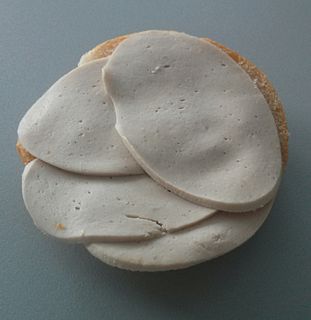 W
WGelbwurst, meaning “yellow sausage”, is a traditional sausage from Bavaria, Germany.
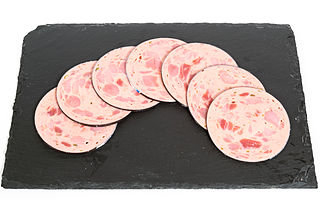 W
WJagdwurst is a German cooked sausage made of lean beef and pork, as well as belly of pork, salt, pepper, garlic, mustard seed, capsicum, mace, cardamom and water, which makes the sausage juicy. Part of the meat is very finely minced, but another part retains its structure. Jagdwurst contains about 20 percent fat.
 W
WKaszanka is a traditional blood sausage in east and central European cuisine. It is made of a mixture of pig's blood, pork offal, and buckwheat kasza stuffed in a pig intestine. It is usually flavored with onion, black pepper, and marjoram.
 W
WKetwurst is a form of hot dog created in the German Democratic Republic. The word "Ketwurst" comes from a combination of Ketchup and Wurst.
 W
WKnackwurst refers to a type of sausage of northern German origin from the mid-16th century. The many available varieties depend on the geographical region of their production.
 W
WKnipp is a type of sausage made by mixing meat with grains (Grützwurst) related to Pinkel which comes from the Bremen and Lower Saxony regions of Germany.
 W
WKochwurst is the name given to the German pre-cooked sausage, a class of sausage whose ingredients are largely cooked before the preparation of the sausage meat. The individual ingredients are held together by solidified fat, gelatine or blood proteins coagulated by heating. In contrast with cooked sausages (Brühwurst), Kochwurst does not remain solid on heating, but more or less liquefies. After being filled into intestines, jars or tins, the whole sausage is cooked through again in hot water or steam.
 W
WKohlwurst, Lungenwurst or Lungwurst is a simple, fresh, strongly smoked sausage (Rohwurst) made of lights, pork and fat, which is mostly eaten cooked with kale (cabbage) dishes such as Knieperkohl. It is mainly used in Northeast and Northwest German and Silesian cuisine, as well as in southwestern parts of Denmark, where it is called "kålpølse".
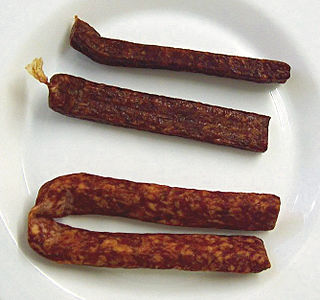 W
WLandjäger is a semidried sausage traditionally made in Southern Germany, Austria, Switzerland, and Alsace. It is popular as a snack food during activities such as hiking. It also has a history as soldier's food because it keeps without refrigeration and comes in single-meal portions. As a meal, landjäger sausage can be boiled and served with potatoes and fresh greens.
 W
WLeberkäse (help·info), is a specialty food found in the south of Germany, in Austria and parts of Switzerland, similar to bologna sausage. It consists of corned beef, pork and bacon and is made by grinding the ingredients very finely and then baking it as a loaf in a bread pan until it has a crunchy brown crust.
 W
WLiverwurst, leberwurst, or liver sausage is a kind of sausage made from liver. It is eaten in many parts of Europe, including Austria, Bulgaria, Croatia, the Czech Republic, Denmark, Finland, Germany, Hungary, Latvia, the Netherlands, Norway, Poland, Romania, Russia, Serbia, Slovakia, Slovenia, Sweden, Ukraine, United Kingdom; it is also found in North and South America, notably in Argentina and Chile.
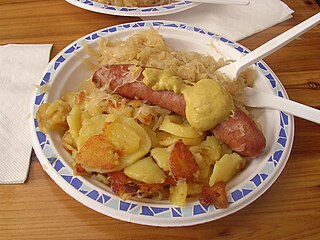 W
WMettwurst is a strongly flavored German sausage made from raw minced pork preserved by curing and smoking, often with garlic. The southern German variety is soft and similar to Teewurst. Braunschweiger mettwurst is partially smoked but still soft and spreadable, while other northern German varieties such as Holsteiner are harder and more akin to salami, due to longer duration of smoking. The Low German word mett, meaning 'minced pork without bacon', is derived from the Old Saxon word meti, and is related to the English word 'meat'. Mettwurst can be prepared and eaten a variety of ways, such as cooked or fried or spread on rye bread with onions and eaten raw. When minced raw pork is prepared without curing or smoking, it is called simply Mett.
 W
WBratwurst is a type of German sausage made from veal, beef, or most commonly pork. The name is derived from the Old High German Brätwurst, from brät-, finely chopped meat, and Wurst, sausage, although in modern German it is often associated with the verb braten, to pan fry or roast. Beef and veal are usually incorporated amongst a blend often including pork.
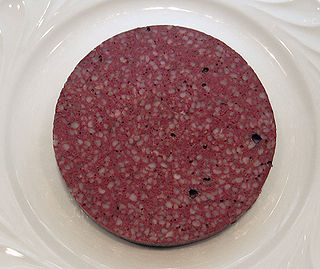 W
WBalkenbrij is a traditional Dutch food that shares some of the characteristics of American scrapple. Traditionally, its preparation and consumption was an important economizing custom, especially for the rural poor. Particularly, it allowed farmers to use various less-desirable parts of pork, which were made more palatable by being added to a seasoned porridge of groats or flour. The closely related 'Panhas', 'Pannas' or 'Möppkenbrot' are widely known in the whole northwest of Germany; the last variety is a speciality of middle Westphalia.
 W
WPinkel is a smoked Kaszanka, which is a type of sausage. It is eaten mainly in northwest Germany, especially the region around Oldenburg, Bremen and Osnabrück as well as in East Frisia and Friesland.
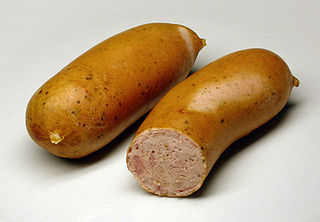 W
WRegensburger Wurst is a boiled sausage with a fine or coarse pork filling. It comes in a compact shape with a length of about 10 cm and a diameter of about 4 cm. It was invented in Regensburg, Germany in the second half of the 19th century and only sausages that are produced in the inner city ring may be called "Regensburger". The local name for the sausages is "Knacker", which can be translated as "cracker" or "crackler".
 W
WSaumagen is a German dish popular in the Palatinate. The name means "sow's stomach". The dish is similar to a sausage in that it consists of a stuffed casing; however, the stomach itself is integral to the dish. It is not as thin as a typical sausage casing. Rather it is meat-like, being a strong muscular organ, and when the dish is finished by being pan-fried or roasted in the oven, it becomes crisp. The dish is somewhat similar to the Scottish haggis, although the stuffing is quite different.
 W
WStadtwurst is a type of sausage consisting of pork in a casing that may be white or red. Stadtwurst is a regional variety in Franconia and Upper Palatinate (Oberpfalz) and usually unknown and not available in other parts of Germany.
 W
WStippgrütze, also called Wurstebrei, is a German dish from Westphalia which is similar to Grützwurst or Knipp. It consists of barley groats cooked in sausage juices (Wurstbrühe), which are enriched with pieces of meat, offal, such as heart, kidney or liver and seasoned with spices and salt. More rarely, finely chopped onions are added. The cooked ingredients are minced after the juices have been poured off and a crumbly cake is left which is held together with fat and which sets on cooling. There are various recipes, but they all contain barley groats, fat and meat.
 W
WTeewurst is a German sausage made from two parts raw pork and one part bacon; they are minced, seasoned and packed in casings before being smoked over beech wood. The sausage then has to mature for seven to ten days in order to develop its typical taste. Teewurst contains 30 to 40 percent fat, which makes it particularly easy to spread.
 W
WBlack pudding, also known as blood pudding, is a distinct regional type of blood sausage originating in the United Kingdom and Ireland. It is made from pork blood, with pork fat or beef suet, and a cereal, usually oatmeal, oat groats or barley groats. The high proportion of cereal, along with the use of certain herbs such as pennyroyal, serves to distinguish black pudding from blood sausages eaten in other parts of the world.
 W
WThuringian sausage, or Thüringer Bratwurst in German is a unique sausage from the German state of Thuringia which has protected geographical indication status under European Union law.
 W
WA Vienna sausage is a thin parboiled sausage traditionally made of pork and beef in a casing of sheep's intestine, then given a low temperature smoking. The word Wiener is German for Viennese. In Austria, the term "Wiener" is uncommon for this food item, which instead is usually called Frankfurter Würstl.
 W
WVolkswagen currywurst is a brand of sausage manufactured by the Volkswagen car maker since 1973. It is manufactured at the company's Wolfsburg plant and sold in restaurants in its six German factories. The currywurst are also sold externally at supermarkets and football stadiums and given away to Volkswagen customers. The sausage is branded as a "Volkswagen Original Part" and has been given the part number 199 398 500 A. The product has been described as the most produced of any of Volkswagen's parts, some 6.81 million sausages being manufactured in 2018. In many recent years the company has produced more sausages than cars. A Volkswagen ketchup is also produced and sold to accompany the currywurst.
 W
WWeckewerk is a sausage, native to Northern Hesse, Germany. It is made from cooked brawn and minced meat, veal or sausage, and broth of pork, sometimes from cooked meat, blood and offal. The sausage is stretched with stale bread, explaining the name: "Weck" or "Wegge" is the traditional term for roll in Northern Hesse. It is seasoned with onions, salt, pepper, marjoram, regionally also with caraway, allspice and garlic. The ingredients are ground and mixed. To be consumed within a short time, the mixture is packaged in pig intestines. If longer storage is desired, it is preserved in jars or filled in artificial casings.
 W
WA Weisswurst is a traditional Bavarian sausage made from minced veal and pork back bacon. It is usually flavored with parsley, lemon, mace, onions, ginger, and cardamom, although there are some variations. Then the mixture is stuffed into pork casings and separated into individual sausages measuring about ten to twelve centimeters in length and three to four centimeters in thickness.
 W
WWollwurst is a speciality similar to Weißwurst made from veal and pork. These sausages are also called "Nackerte", "Geschwollene", "Geschlagene" or "Oberländer" and are usually longer and thinner than Weißwürste.